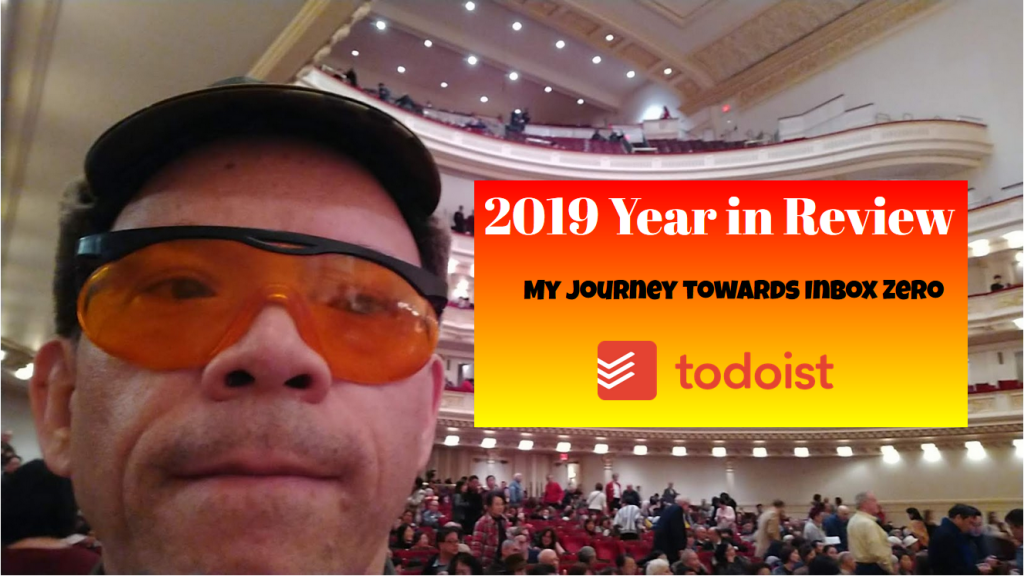
A Fast Way to Clean Up Email.
Unfortunately most people are still using the inbox for a combination of reference, trash, still cannot decide what to do with this, reminders of things to do and everything else.
And then you go numb to that because you’ve lost the function of the in basket which needs to only hold un-thought of, unprocessed or undecided about stuff.
Once you have decided what these things mean, they ought to get out of INBOX so that you maintain its capture function, which needs to be very discreet. You do not want to blend other functions together. Email inbox is exclusively used for capturing inputs from other people and nothing else.
First of all delete everything you need to delete. Use the DEL key on your computer. Dump stuff you do not need to keep track of.
Then move to the second step called file it to get it out of your inbox. File anything you do not want to loose. Put actionable items into Todoist for subsequent follow up.
Apply the two-minute rule which is part of the David Allen Getting Things Done (GTD) methodology. Once you determine that the next action on a message can be done in 2-minutes or less you should do it right then because it will take you longer to organized it than to “Just Do it.” Then move the message out of inbox. Most email programs have an “Archive” folder exactly for this purpose.
Ask yourself: what do I need to do with this email and can it be done in less than 2-minutes, then just do it right in the moment if it can be done.
So if you delete all that can be deleted, file the rest out of the inbox and handle the two-minute stuff, there will be only two kinds of emails left. Emails that take more than two-minutes to complete, and emails that require a waiting period on to revisit. Say from somebody else.
The goal is to clear the inbox. The only items in inbox are items to delete, stuff for future reference, things that take just 2 minutes to finish, and other email that require some thought and consideration to respond to or whatever.
Use the Email inbox as strictly a capture tool. After messages arrive in the inbox, next step is to clarify what needs to be done and then move the message to another trusted system like Todoist for later follow up.
This is a very simple method. There are a lot of other ways to manage a bloated email inbox given the different software and apps out there in the market. But it is a fast way for anybody to get control of an email inbox. If you apply this principle, then you can customize exactly how this is done. There are an infinite number of ways to address this problem using the principle I am presenting here. Feel free to experiment and come up with your own custom solution.
Do Not Use Email as Reference Point
Imagine for a second a man checking his postal mailbox. He scans through the day’s mail, identifying bills to pay, magazines to browse, and letters to read.
Then he stuffs everything right back into the physical mailbox, the overdue electricity bill right alongside the junk mail, the personalized postcard together with the tax forms. Each day he repeats this ritual, his mailbox overflowing and bursting at the seams with each passing day.
My old self
“I don’t need a system? — I just
keep everything in email!”
Ridiculous, right?
But this is exactly how I was handling my email every day. Just make the mailbox infinitely bigger, the delivery nearly continuous, and the variety of letter types radically more diverse.
Second, Strip Email Down to its Core Function
The main problem with how people use email is that they use it for everything.
You wouldn’t buy a multi function toaster-power drill-toilet bowl cleaner, would you? You wouldn’t find a combination leaf blower-immersion blender particularly useful, right?
And yet for a tool central to our working lives, that represents a far worse compromise of incompatible functions, we somehow put up with a Frankenstein-like monstrosity of a communication tool/to do list/project manager/notification system/composition tool/reading list/file storage area/reference library/conversation archive/planning tool/note-taking app.
We hired email for one simple job, and now it’s the codependent handyman living in our basement, banging away at odd jobs late into the night.
Let’s turn back the tide and strip email down to its original function, the only one that it does better than any other tool: collecting new inputs. That’s it.
We hired email for one simple job, and now it’s the codependent handyman living in our basement, banging away at odd jobs late into the night. Let’s turn back the tide and strip email down to its original function, the only one that it does better than any other tool: collecting new inputs. That’s it.
Every other function is much more effectively handled by one of four purpose-built productivity apps, in the same way that our fictional friend could have benefited from a to do list, an agenda, a filing cabinet, a magazine rack, and a trash can.
In fact—those are exactly the tools we’re going to set up, but the digital versions.
The crazy thing is, stripping Gmail down to this core function takes a lot of work. The Gmail team has surrendered to our demands to have everything happen in email, and now we have to cut off all the freakish mutated appendages to get something usable.
Stars, personal level indicators, system labels, categories, circles, labels, importance markers, filters—get rid of them all, and breathe a sigh of relief.
Third, set up four downstream systems
Try Todoist today. Todoist is a system to segregte the most important messages out of email and help you reach inbox zero nirvana. The software is free to use. Distributed on Freemium basis. Meaning most of the basic features are free to use. Only the most advanced 20% of features are locked and requires payment to use.
You need a list manager. Which is a tool to organize reminders. That is what Todoist is. Once you decide upon the next actions, just file it away in Todoist.
“I must create a system or be enslaved by another man’s”?
William Blake
Todoist is a list manager, where you can set categories and find things for later follow up. It can manage any type of lists. If you really go through this process and clarify your open loops and its work flow, you would have a list called show me all the things I need to do at my computer, Show me the stuff to buy at the store, show me the stuff to talk with your partner about, issues to bring up at the board meeting, errands to run and etc. Todoist is an app to easily create lists and reminders of things to do. It also works properly while offline.


